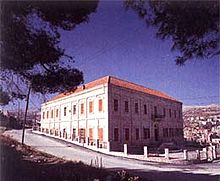Zahlé
[9] Its relative geographic isolation from the local centres of power in Mount Lebanon and Syria caused the village not to have any significant allies in the region to fall back on in case of conflicts or attacks.The Shiite 'Usayran family, for example, is also said to have left Baalbek then to avoid expropriation by the Harfushes and established itself as one of the premier commercial households of Sidon and later even served as consuls of Iran.[12] On 7 September 1975, during the civil war, the Lebanese Forces militia, at that time led by Elie Hobeika agreed to 100 Syrian soldiers and 20 intelligence officers taking up strategic positions in the town.[17][better source needed] While several Middle Eastern cities (including Damascus, Cairo and Amman) have larger Christian communities, these do not constitute a majority.Zahlé's Muslim minority (around 27% of the population) is concentrated in the neighborhoods of Karak Nuh (where Noah's tomb is allegedly located) and Haoush al-Umara, specifically, in an area named "Hay al-watani", on the northeastern and southwestern edge of town, respectively.[citation needed] A number of companies and state bodies have their headquarters for the Beqaa region in Zahlé, including the Central Bank of Lebanon and the Lebanese Chamber of Commerce.Institutes of higher education currently represented in the town include: Zahlé is connected to Beirut (55 kilometres (34 mi) to the west), and from there to all coastal cities, through the Beirut-Damascus road, which passes to the southwest of the urban area.Despite continuously undergoing works and repairs, the Beirut-Damascus road remains in poor condition, and is due to be replaced by a new, multimillion-dollar highway as the main international route;[20] however, the completion date is still unclear.There were plans to convert the nearby Rayak Air Base (located 10 km (6 mi) to the East of Zahlé), into a civil airport serving the town and the whole valley.Located just downhill from Our Lady of Zahlé and Bekaa, it is a mix of local and Ottoman architecture, and features an atrium occupied by an inner garden and surrounded by arcades.This grandiose complex dates back to 1720, and consists of a series of stone-clad buildings around a large inner courtyard: the church itself (which is the oldest part), the seat of the Archbishop (a converted former monastery), and a small chapel housing an icon, which is said to be a reproduction of a portrait of the Virgin Mary by Saint Lucas.In 2003, the municipality covered a 25 m (82 ft) fir (the park's tallest) with thousands of lights, in an attempt to break the world record for the largest natural Christmas tree.Zahlé in itself offers little archaeological interest;[citation needed] however, the Château Ksara winery is worth a visit for its maze of vaults which dates back to Roman times.Zahlé's most important cultural event is the "Festival of the Vine", traditionally held each September, during which concerts, plays, poetry evenings and artistic exhibitions are organized daily over the course of two or three weeks.The final Saturday evening features the crowning of the "Maid of the Vine", the local beauty queen, and the next afternoon, the festival closes with arguably its most popular event: a parade of floats held on the town's main avenue.






Zahle (surname)Zahle (disambiguation)LebanonGovernorateBeqaa GovernorateDistrictZahlé DistrictTime zoneArea codeArabicBeirutTripoliJouniehDamascusMount LebanonBeqaa ValleyChristiansGreek CatholicMelkite Greek CatholicdeforestedHarfush dynastyOrthodoxShiiteBeka'aEgyptianCrimean Wargrain traderegion of SyriaAleppocivil warLebanese ForcesElie HobeikaSyrianurban areaSaadnayelTaalabayaChtaurametropolitan areaKab EliasBar EliasChristianShia IslamSunni IslamMuslimsGreek CatholicsMaronite CatholicsGreek OrthodoxShiite MuslimsSyriac OrthodoxSunni MuslimsMiddle EastCatholicsMaroniteMuslimKarak NuhSunnisJewishLebanese Civil WarColombiaVenezuelaBrazilArgentinaAustraliaUnited Arab EmiratesCentral Bank of LebanonChamber of CommerceLebanese UniversitySaint Joseph UniversityHoly Spirit University of KaslikAntonine UniversityAmerican University of Science and TechnologyBaalbekrailway stationRayak Air BaseOttomanSerailTown HallWorld War ImosaicChâteau KsaraQabb IlyasUmayyadHellenisticWorld Heritage SitePhoenicianKamed al LawzBronze AgePersianByzantinecafésbeauty queenfloatsProphet Elias (Elijah)patron saintbubonic plagueMediterranean climateKöppen climate classificationprecipitationShakiraSaid AklUnited NationsCharles ElachiElias HrawiJoseph RayaLouis KhalilMaronite ChurchNajwa KaramWael KfouryIsabel BayrakdarianKarl SharroMário ZagallotwinnedBordeauxIssawi, CharlesMiddle East InternationalLord MayhewDennis WaltersJim MuirAlixa NaffThe New YorkerZahle DistrictAin Kfar ZabadAli an NahriBareliasBouarejDeir El Ghazal